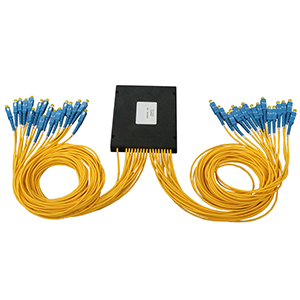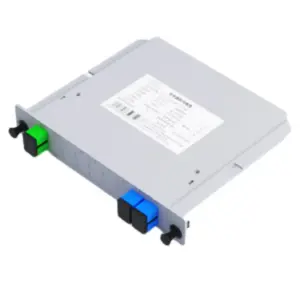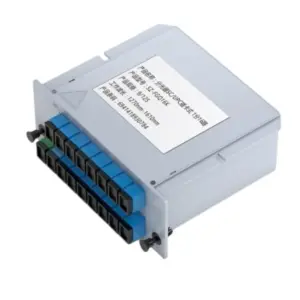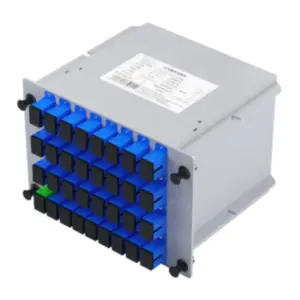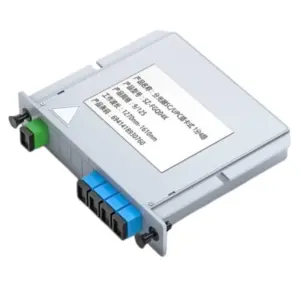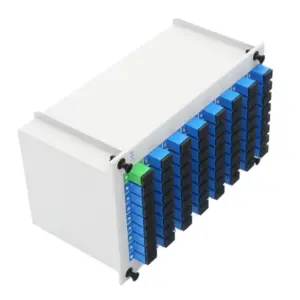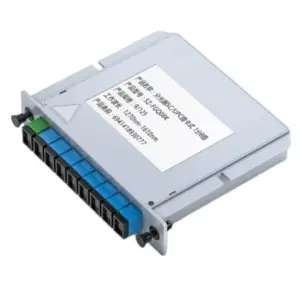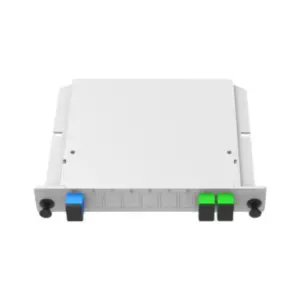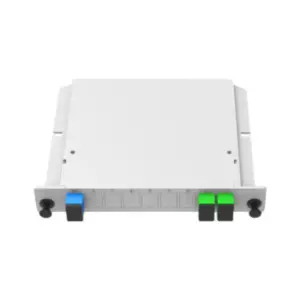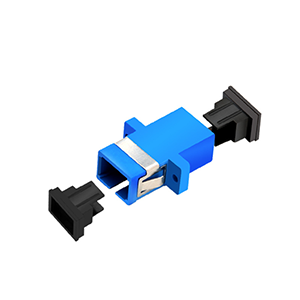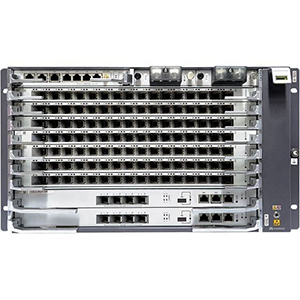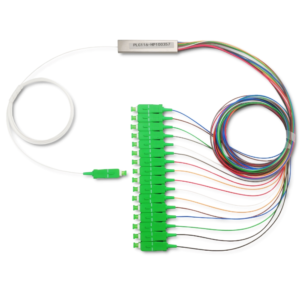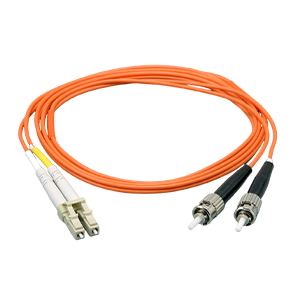Hello everyone! Today I want to share with you a piece of equipment that plays an important role in fiber optic networks – fiber optic splitters. As a key component in fiber optic networks, fiber optic splitters play an important role in achieving efficient data transmission and signal distribution. In this article, I will take you in-depth understanding of the principles, types and application fields of fiber optic splitters, so that you can better understand its importance and advantages.
Overview of fiber optic splitters
Optical fiber network is a communication network that uses optical fiber as the transmission medium. It uses the transmission characteristics of light to transmit data signals. Optical fiber networks have the advantages of high bandwidth, low loss, and strong anti-interference, and are widely used in fields such as long-distance communications, data transmission, and Internet connections.
The basic principle of optical fiber networks is to utilize the total internal reflection and transmission characteristics of light. The optical signal is transmitted by total reflection through the core of the optical fiber. The core of the optical fiber is composed of slender glass or plastic fibers, and is covered with a layer of material (cladding) with a lower refractive index to keep the optical signal in the fiber. Propagation within the core.
In fiber optic networks, fiber optic splitters play an important role. Optical fiber splitters are used to split an input optical signal into multiple output optical signals, or to combine multiple input optical signals into one output optical signal. It is usually used in distributed optical fiber transmission systems in networks, allowing optical signals to be transmitted in different directions to achieve multiplexing and distributed connections.
Fiber optical splitters are usually located at key locations in optical fiber networks, such as optical fiber splitting boxes, optical switches or optical fiber distribution frames. Its function has two aspects:
- Optical signal distribution: Fiber optic splitters can divide an input optical signal into multiple output optical signals, so that the optical signals can be transmitted to different target devices or terminals at the same time.
- Optical signal merging: Fiber optic splitters can also combine multiple input optical signals into one output optical signal to achieve combined transmission of multiple optical signals.
In addition to fiber optic splitters, fiber optic networks also include other important components, such as fiber optic transceivers (optical modules), fiber optic switches, fiber optic amplifiers, and fiber optic attenuators. Fiber optic transceivers are used to convert electrical signals into optical signals for transmission and reception, fiber optic switches are used for routing and forwarding of fiber optic signals, fiber optic amplifiers are used to enhance the intensity of optical signals, and fiber optic attenuators are used to adjust the intensity of optical signals.
So optical fiber networks use the transmission characteristics of light to achieve high-speed, long-distance data transmission. Fiber optic splitters play an important role in distributing and combining optical signals in fiber optic networks, while other components work together to build an efficient and reliable fiber optic network system.
Overview of the working principle of fiber optic splitters
An optical fiber splitter is an optical device used to distribute and combine optical signals. It realizes the distribution and merging functions of optical signals based on the interference principle of light and the effect of multi-mode interference.
Fiber optical splitters usually consist of a main optical fiber and multiple branch optical fibers. A main fiber is a fiber that contains a core and cladding, while a branch fiber is a fiber that branches off from the main fiber. Inside the fiber splitter, there is a specific optical coupling structure between the main fiber and the branch fiber. Common ones include fiber couplers and gratings.
The basic working method of fiber optic splitter is as follows:
Optical signal distribution: When an input optical signal enters the main fiber, it will propagate in the main fiber. Part of the optical signal will continue to be transmitted in the main optical fiber, while another part of the optical signal will be distributed to the branch optical fiber through the optical coupling structure. Optical signals distributed into branch fibers can be transmitted to different target devices or terminals.
Optical signal combining: When multiple input optical signals enter the fiber splitter through their respective branch fibers, they interfere at the optical coupling structure. Interference effects cause the merging of optical signals. The combined optical signals will be transmitted through the main optical fiber and finally reach the target device or terminal.
The principle of fiber optic splitters is based on the interference effect of light, which is caused by light waves traveling on different paths and interfering with each other. The optical coupling structure in the optical fiber splitter can guide the optical signal to interfere between the main fiber and the branch fiber, thereby realizing the distribution and merging of the optical signal.
Fiber optic splitters feature high efficiency and low insertion loss. High efficiency means that the fiber optic splitter can accurately distribute the input optical signal to the target device or terminal, and effectively combine multiple input optical signals together. Low insertion loss means that during the optical signal distribution and combining process, the optical signal loss introduced by the optical fiber splitter is very small, thus maintaining high-quality transmission of optical signals.
What are the characteristics of fiber optic splitters
Fiber optic splitters can be classified according to their structure and working principles. Two common types are planar waveguide fiber splitters and spherical waveguide fiber splitters.
Planar waveguide fiber splitter:
Planar waveguide fiber optic splitters are one of the most common types of fiber optic splitters. It adopts a planar waveguide structure in which the main fiber and the branch fiber are located on the same plane. Planar waveguide beamsplitters are usually based on coupling devices such as Y couplers or T couplers. These coupling devices utilize the mode coupling and interference effects of waveguides to distribute and combine optical signals.
Features and advantages:
- Simple structure: Planar waveguide fiber splitters have a relatively simple structure and are easy to manufacture and integrate.
- Wide operating band: They can operate within a wide band, allowing the transmission of optical signals of multiple wavelengths.
- Low insertion loss: Planar waveguide optical splitters typically have low insertion loss and can accurately distribute and combine optical signals.
- Scalability: This type of beam splitter can expand its splitting capabilities by increasing the number and length of waveguides.
Spherical waveguide fiber splitter:
The spherical waveguide fiber splitter adopts a spherical waveguide structure, in which the main fiber and the branch fiber are located on the spherical surface. Spherical waveguide beam splitters utilize the mode distribution and coupling effects of spherical waveguides to distribute and combine optical signals.
Features and advantages:
- Compact structure: The spherical waveguide fiber splitter has a compact structure and is suitable for use in small-sized equipment.
- High splitting ratio: The spherical waveguide optical splitter can achieve a high splitting ratio, that is, the input optical signal is accurately distributed to the branch optical fiber, reducing signal loss.
- Low crosstalk: Spherical waveguide optical splitters generally have low crosstalk performance and can maintain optical signal isolation between branch fibers.
The common features of fiber optic splitters are their high splitting ratio and low crosstalk performance. A high splitting ratio means that the optical fiber splitter can accurately distribute the input optical signal to the target branch fiber and avoid the loss of optical signal to the greatest extent. Low crosstalk performance means that the optical fiber splitter can reduce or eliminate optical signal interference between branch fibers and maintain the purity and reliability of the optical signal.
What are the application fields of fiber optic splitters
Fiber optical splitters are widely used in various fields. The following are some application cases of fiber optic splitters in different fields:
Optical communication:
- Multi-wavelength optical splitting: Optical fiber splitters are used to separate and combine optical signals of multiple wavelengths to achieve multi-wavelength optical communication systems.
- Optical network distribution: Fiber optic splitters are used to distribute optical signals to different optical fiber links to realize optical signal transmission and routing in the network.
- Spectral analysis: Fiber optic spectrometers are used in spectrum analysis instruments to separate optical signals by wavelength for spectral analysis and measurement.
Wireless network:
- Fiber optic wireless distribution system: Fiber optic splitters are used to distribute optical signals to wireless antennas to achieve distributed transmission of broadband wireless networks.
- Fiber Bragg grating antenna: Fiber optical splitter combined with grating technology is used to implement fiber Bragg grating antenna system to provide high-speed, high-capacity wireless communication.
Data Center:
- Optical fiber interconnection network: Fiber optic splitters are used in fiber optic interconnection networks in data centers to achieve high-speed, high-density optical signal distribution and merging.
- Fiber optic sensing network: Fiber optic splitters are used in data centers to build fiber optic sensing networks to monitor environmental parameters such as temperature, pressure, humidity, etc., to achieve intelligent management and security monitoring.
Network expansion and distributed sensing systems:
- Fiber optic sensing network expansion: Fiber optic splitters are used to expand the coverage of fiber optic sensing networks and distribute sensing signals to different fiber optic links to achieve long-distance transmission and monitoring.
- Fiber optic distributed sensing system: Fiber optic splitters combined with fiber optic sensing technology are used to build a distributed sensing system to achieve real-time monitoring and data collection of large areas.
In these application fields, the main function of fiber optic splitters is to realize the distribution and combination of optical signals and provide efficient optical transmission and optical network management capabilities. The high splitting ratio and low crosstalk performance of fiber optic splitters are critical to ensuring signal quality and system performance. Through the application of optical fiber splitters, high-speed, high-capacity and reliable optical communications, wireless networks and data center systems can be realized, while promoting the development of network expansion and distributed sensing technology.
How to install and maintain fiber optic splitters
The installation and maintenance of fiber optic splitters require certain techniques and precautions. Here are the key steps and considerations:
Installation notes:
- Environment selection: Choose a dry, dust-free, non-corrosive gas and suitable temperature environment for installation to avoid adverse effects on the fiber optic splitter.
- Optical fiber processing: Correctly handle the fiber end face to ensure it is smooth and clean to avoid contamination and damage. Use appropriate cleaning tools and methods for handling fiber optics.
- Connection check: Before making a connection, check whether the fiber optic connection interface and socket are clean and intact to ensure the quality and stability of the connection.
- Positioning and fixing: Correctly position and fix the fiber optic splitter to avoid external vibration and physical impact.
Maintenance precautions:
- Cleaning Protection: Regularly clean the outside and inside of the fiber optic splitter to remove dust and dirt. Use appropriate cleaning tools and methods for cleaning and avoid using substances that may damage optical fibers.
- Regular inspection: Regularly check the connections and interfaces of the fiber optic splitter to ensure its stability and quality. Check whether the optical fiber is damaged, bent or broken, and repair or replace it in time.
- Environmental monitoring: Regularly monitor the environmental conditions of the fiber optic splitter, including temperature, humidity, etc., to ensure that it is working in a suitable environment.
- Troubleshooting records: Record the faults and problems of the fiber optic splitter, and take appropriate measures to repair them in a timely manner. Establish records and documentation of troubleshooting for future reference and analysis.
Proper handling and protection of fiber optic splitters is critical:
- Avoid bending: Avoid excessive bending of the optical fiber to avoid optical signal loss and breakage.
- Prevent pulling and pulling: Avoid exerting excessive pulling and pulling on the optical fiber to prevent fiber breakage and loose connections.
- Prevent contamination: Avoid dust, grease and other contaminants coming into contact with the connection part of the fiber optic splitter to maintain the purity of the optical signal.
FAQs and troubleshooting:
- Insertion loss increases: Check whether the optical fiber connection is stable, re-insert and unplug the optical fiber and clean the end face to ensure the connection quality.
- Signal loss: Check whether the optical fiber connection is correct, check whether the optical fiber is damaged or broken, and repair or replace the problematic optical fiber.
- Increased crosstalk: Check the environmental conditions of the fiber optic splitter to ensure there are no external sources of interference, such as electromagnetic fields or other light sources.
To sum up, the installation and maintenance of fiber optic splitters require attention to fiber handling, connection quality, environmental selection and regular inspections. Proper handling and protection of fiber optic splitters ensures their performance and reliability. When encountering problems, take timely troubleshooting measures to check connections, fiber status, and environmental conditions to ensure the normal operation and operation of the fiber optic splitter.
Summary
As the core equipment of optical fiber networks, fiber optic splitters exhibit outstanding performance in various fields with their high performance and low insertion loss. Whether you are in optical communications, wireless networks or data centers, fiber optic splitters can distribute and combine signals, helping you achieve high-speed and reliable data transmission.
We provide various types of fiber optic splitters, such as planar waveguide fiber optic splitters and spherical waveguide fiber optic splitters as well as plc optical splitter, to meet different needs and application scenarios. If you have more questions about fiber optic splitters or need more details, please feel free to contact us.
Fiber Splitter FAQ
A fiber splitter uses a special waveguide or fused fiber technology to split or combine light signals. It divides the optical power evenly among the output ports or combines the power from multiple input ports into a single output port.
The common types of fiber splitters are: 1×2, 1×4, 1×8, 1×16, 1×32, and 1×64, where the first number represents the number of input ports and the second number represents the number of output ports.
In the context of fiber optics, the terms “splitter” and “coupler” are often used interchangeably to refer to the same device. Both terms describe a passive device that divides or combines optical signals.
Fiber splitters are commonly used in passive optical networks (PONs) for distributing signals to multiple subscribers, in fiber-to-the-home (FTTH) installations, in telecommunications networks, and in various fiber optic sensing applications.
Yes, fiber splitters can be designed to work with both single-mode and multimode fibers. It is important to choose the appropriate type of splitter that matches the fiber type being used.
The splitting ratio of a fiber splitter refers to the division of the optical power among the output ports. For example, a 1×4 splitter would have a 1:4 splitting ratio, where each output port receives 25% of the input power.
Yes, fiber splitters can be cascaded or connected in series to achieve further splitting. This allows for more output ports and greater distribution of optical signals.
Yes, fiber splitters introduce a certain amount of signal loss due to the splitting process. The level of loss depends on the splitting ratio and the quality of the splitter. It is important to consider the loss budget when designing a fiber optic network.
Yes, fiber splitters can be used for bidirectional transmission by combining signals from multiple input ports into a single output or by splitting a signal from a single input into multiple outputs.

